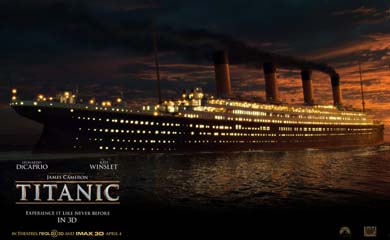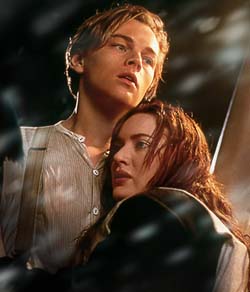Last month, like a lot of other people around the world, I bought a ticket to the 3-D-tailored release of James Cameron’s 1997 mega-hit Titanic. Boosted by the centenary of the April 15, 1912, Titanic disaster, the movie passed the $2 billion box-office marker, becoming only the second film in motion picture history to reach that figure—the other being Cameron’s sci-fi fantasy Avatar (2009). I’d be interested to hear others’ reactions to the addition of the 3-D imagery. For me it seemed rather inconsequential aesthetically, largely because the digitally generated special effects and camera compositions delivered a powerful dynamism on their own. In-depth blocking, combined with constant tracking and dolly shots, beautifully captured the action as the passengers flowed through the splendid ship during Titanic’s first half.
 The film’s second half, which charted events from the ship striking the iceberg until it sank beneath the North Atlantic, displayed masterful special effects, especially of the seawater invading and dooming the “unsinkable” Titanic. Here, Cameron made good use of talents with digitalized water effects he honed in the 1989 film The Abyss. In Titanic, with the confining corridors of the ship as visual parameters for the sea’s increasing vengeance, Cameron channeled gushing streams of water directly at the camera lens. The special effects imagery was powerfully menacing without 3-D embellishment.
The film’s second half, which charted events from the ship striking the iceberg until it sank beneath the North Atlantic, displayed masterful special effects, especially of the seawater invading and dooming the “unsinkable” Titanic. Here, Cameron made good use of talents with digitalized water effects he honed in the 1989 film The Abyss. In Titanic, with the confining corridors of the ship as visual parameters for the sea’s increasing vengeance, Cameron channeled gushing streams of water directly at the camera lens. The special effects imagery was powerfully menacing without 3-D embellishment.
The same can be said for the iconic romantic moment when the rebellious Rose (Kate Winslet) and her steerage suitor Jack (Leonardo DiCaprio) stand on the bow railings of the Titanic and with raised arms seem to fly off into the Atlantic sunset. That shot worked its effect just as well in two dimensions.
A compelling saga
Over the years there have been dozens of books, films, made-for-television movies, documentaries, stage dramas, and at least one stage musical about the Titanic. It’s fascinating how many different approaches filmmakers and other media artists have taken in telling the story of that fateful night in April 1912. The compulsion to capitalize on the tragedy was immediate. A German-made silent short came out in 1912 as well as one by the Gaumont studios, titled Titanic Leaving Belfast Lough.
Prior to seeing the 3-D Titanic re-release, I revisited some of the earlier cinematic treatments of the sea disaster with an eye to seeing how Cameron, who had also written the screenplay for his version, drew from previous work.
Interestingly, the first feature-length telling of the Titanic story was a multi-language British film (English/French/German) adapted from a 1915 stage play, “The Berg” written by English novelist Ernest Raymond. The film was shot in 1929 and titled Atlantic (after the Titanic’s White Star Line company forbade the use of their ship’s name.)
Atlantic was directed by German expat E.A. Dupont in a screen version that stuck closely to the stage play. Most of the dialogue is delivered in a first-class smoking lounge where an assortment of passengers come and go, many carrying with them deep personal problems. Once the ship strikes the iceberg, the characters converge in the space, expressing their reactions to the deepening crisis. It’s easy to see how this treatment would work on a proscenium stage. In the film adaptation most of the cutaways to other areas of the ship have the feel of a silent movie with the imagery often underscored only by repetitive sound effects: orchestral dance music from the ballroom, slushing sea water in the boiler rooms, the clang of bells from the crow’s nest. The most powerful and realistic sequence of Atlantic occurs in the boarding and lowering of the ship’s inadequate number of lifeboats. Chaotic imagery of those stranded is accompanied by a cacophony of vocalized screaming.
A moment of dramatic irony in Atlantic, and one repeated in Cameron’s film, involves a bartender who at the height of the crisis continues mixing cocktails for the men in the lounge. Another repeated script element is the obligatory inclusion of the hymn “Nearer My God to Thee.” It’s sung in Atlantic by passengers just as the ship is sinking; it’s mournfully rendered by a string quintet in the climactic phase of Cameron’s film (below).
Tragedy as propaganda tool
One of the most intriguing treatments of the doomed ship appeared in the German-made Titanic (1943), commissioned in 1942 by Nazi propaganda minister Joseph Goebbels. The screenplay by Herbert Selpin and Walter Zerlett-Olfenius invented a German officer serving on the Titanic who passionately pleads for the ship’s speed to be slowed to avert disaster. This fictional German named Petersen (Hans Nielsen) is depicted as brave and selfless—a propagandistic contrast to the Titanic’s White Star Line owners who are driving the ship’s steam engines at full speed in order to arrive early in New York and garner headlines that could boost the company’s stock values. CEO J. Bruce Ismay, traveling on the maiden voyage, is drawn as a British capitalist whose greed results in the tragic loss of more than 1,500 lives.
Ismay’s urgency for speed is very much a part of Cameron’s script, but its plot significance is of secondary importance to the romantic arcs centered on Jack and Rose. Cameron does in the end depict Ismay as a cowering cad when he’s shown slipping onto one of the lifeboats meant for women and children. As a footnote, when the German Titanic was completed in 1943, the film was banned by Berlin censors who felt its story of panic and death would be inappropriate for a country experiencing nightly Allied bombing raids. Instead it premiered in November 1943 in German-occupied Paris and later opened in Prague.
Unsinkable themes
 I watched two films that were particularly interesting for their character and plotting situations that resembled those developed around Jack and Rose in Cameron’s rendition. First was Titanic, produced at 20th Century Fox in 1953. In its Oscar-winning screenplay by Charles Brackett, Walter Reisch, and Richard Breen, Barbara Stanwyck portrays a disillusioned wife who is traveling aboard the Titanic with her snooty upperclass husband (Clifton Webb). To elude him and prevent her two children from adopting his high-society ways, Stanwyck escapes to steerage quarters. Taking a varied tack on this character conflict, Cameron’s Rose is caught up in a similar stultifying relationship with haughty upper-class fiance Cal (Billy Zane). With the help of Jack, a steerage passenger, Rose flees from Cal and begins to experience the freedom she desires.
I watched two films that were particularly interesting for their character and plotting situations that resembled those developed around Jack and Rose in Cameron’s rendition. First was Titanic, produced at 20th Century Fox in 1953. In its Oscar-winning screenplay by Charles Brackett, Walter Reisch, and Richard Breen, Barbara Stanwyck portrays a disillusioned wife who is traveling aboard the Titanic with her snooty upperclass husband (Clifton Webb). To elude him and prevent her two children from adopting his high-society ways, Stanwyck escapes to steerage quarters. Taking a varied tack on this character conflict, Cameron’s Rose is caught up in a similar stultifying relationship with haughty upper-class fiance Cal (Billy Zane). With the help of Jack, a steerage passenger, Rose flees from Cal and begins to experience the freedom she desires.
In A Night to Remember (1958), made in England by J. Arthur Rank, Eric Ambler’s script includes a deeply-in-love, beautiful young couple who refuse to be separated when women are urged into the lifeboats. The couple jump together from the Titanic as it sinks. Afterwards they are seen floating together on wooden flotsam—she holding to the edge and eventually dying of hypothermia. Cameron reverses his climactic treatment of the committed-forever couple with Jack dying in the water and Rose surviving—a principal plotting turn that allows the elderly Rose to retell her love story to explorers who are searching the sunken Titanic for hidden treasures.
Critics generally concur that A Night to Remember best captures the Titanic tragedy. The screenplay was adapted from Walter Lord’s outstanding book of the same title with the film’s primary focus being the ship itself. The producers diligently worked to stay as close to the facts as possible and to treat the event as tragedy rather than melodrama.
Survivors assisted in the accumulation of plotting details and in recounting passenger and crew reactions to events after striking the iceberg. The film especially was praised for its clear, even-handed treatment of the three passenger classes. Any significant indications of class antagonism were avoided in an effort to depict the greater tragedy of the disaster. While Cameron’s Titanic massages the senses with its emotional viscera, A Night to Remember is the film to watch for its serious, non-romanticized rendering of a Promethean tale where human ingenuity succumbs to the power of nature.
Which version of the Titanic story do you favor?



Tim Artist - '79 & '82
My choice is “A Night to Remember”.
Reply
Ramona - 1984
3D in general is a meaninglss gimmick, and I can’t watch any rerelease because I can’t watch anything about the Titanic without going crazy that the ending can’t be rewritten.
Reply